What Are Hollow Bricks | Advantage of Hollow Bricks | Disadvantage of Hollow Bricks | Sizes of Bricks Blocks | How to Make Hollow Bricks
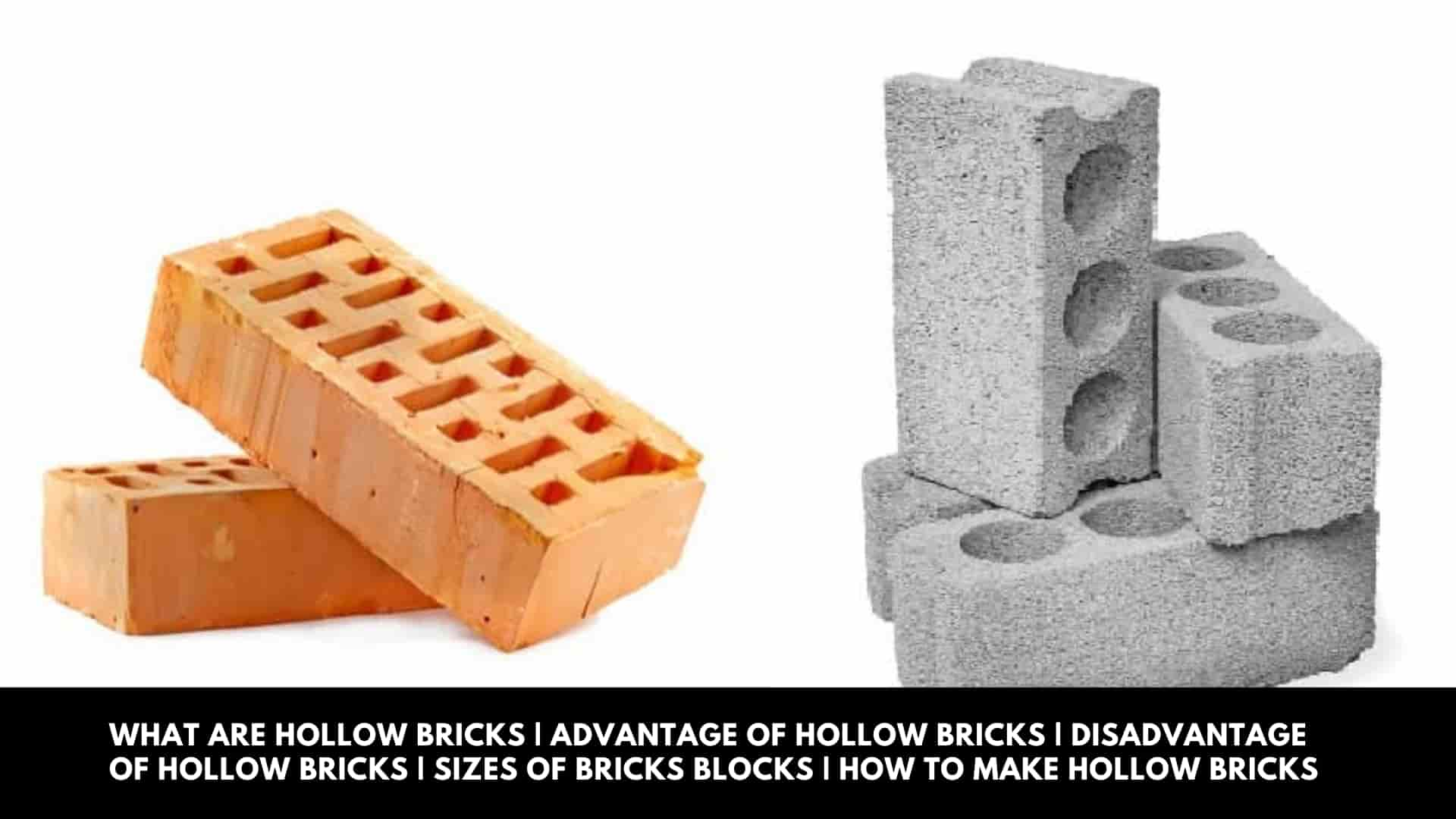
Table of Contents
Introduction of Hollow Bricks
Bricks are one of the most essential and commonly used Building units in the construction world after cement.
Traditional bricks are widely used in the construction of Buildings. Nowadays there are many innovations and research going on in the construction industry to develop innovative and cost-effective Construction materials which have more advantageous and economical as compared to traditional building materials.
In this article, we will see about hollow bricks and their Advantages and Disadvantages. The Hollow brick is the new innovative building unit that is becoming popular for its various uses. Hollow bricks Construction is eco-friendly in nature and does not create any pollution in nature.
What Are Hollow Bricks?

Hollow bricks are also known as Eurotherm bricks. It is a new-age brick that is widely gaining popularity in the construction industry.
Hollow bricks are perforated either horizontally or vertically. The overall performance of the hollow bricks is very good as compared to the traditional bricks.
Hollow bricks are very easy to handle on-site and help in faster construction. They are environment friendly and absorb less amount of water as compared to traditional clay bricks.
Because of its low Absorption of water, there are very few chances of efflorescence on the hollow brick walls. Hollow bricks help to improve the aesthetical beauty of the structure and give a better view and surface as compared to the Construction of traditional bricks.
Hollow Brick Construction is rated by the Green Building Council of India. Hollow bricks are eco-friendly Construction materials that are manufactured from recycled waste and materials such as coal ash, rice husk, and fly ash.
Hollow bricks are an innovative construction material that is a substitute for the traditional bricks which are used in construction.
The main function of hollow bricks is to reduce the dead load of the Structure because hollow bricks are the most lightweight building materials. The holes or the pores present in the bricks help to reduce the weight of the brick and make it lightweight.
The Hollow brick wall is mostly used as the partition in buildings but it is also used as the load-bearing wall as per the Compressive strength of the hollow brick.
The hollow bricks have the thermal insulation property which helps to reduce the cooling as well as heating effects as per the weather conditions.
The hollow space of the poles which are present in the hollow bricks is used to pass the plumbing as well as electrical wiring which is not possible in the traditional bricks.
The thermal insulation property of the hollow bricks helps to save resources and costs. It is because of the air present in the holes of the hollow bricks which helps the hollow bricks wall to keep the internal environment of the building cool in the summer and warm in winter.
The Thermal insulation of the hollow bricks is more as compared to the traditional bricks. The bonding capacity of the hollow bricks is very high because the concrete can be filled in the pores of hollow bricks which helps to improve its strength.
Hollow bricks provide uniform quality, faster construction, and less labor involvement and hence prove economical and cost-effective Construction material.
Advantage of Hollow Brick
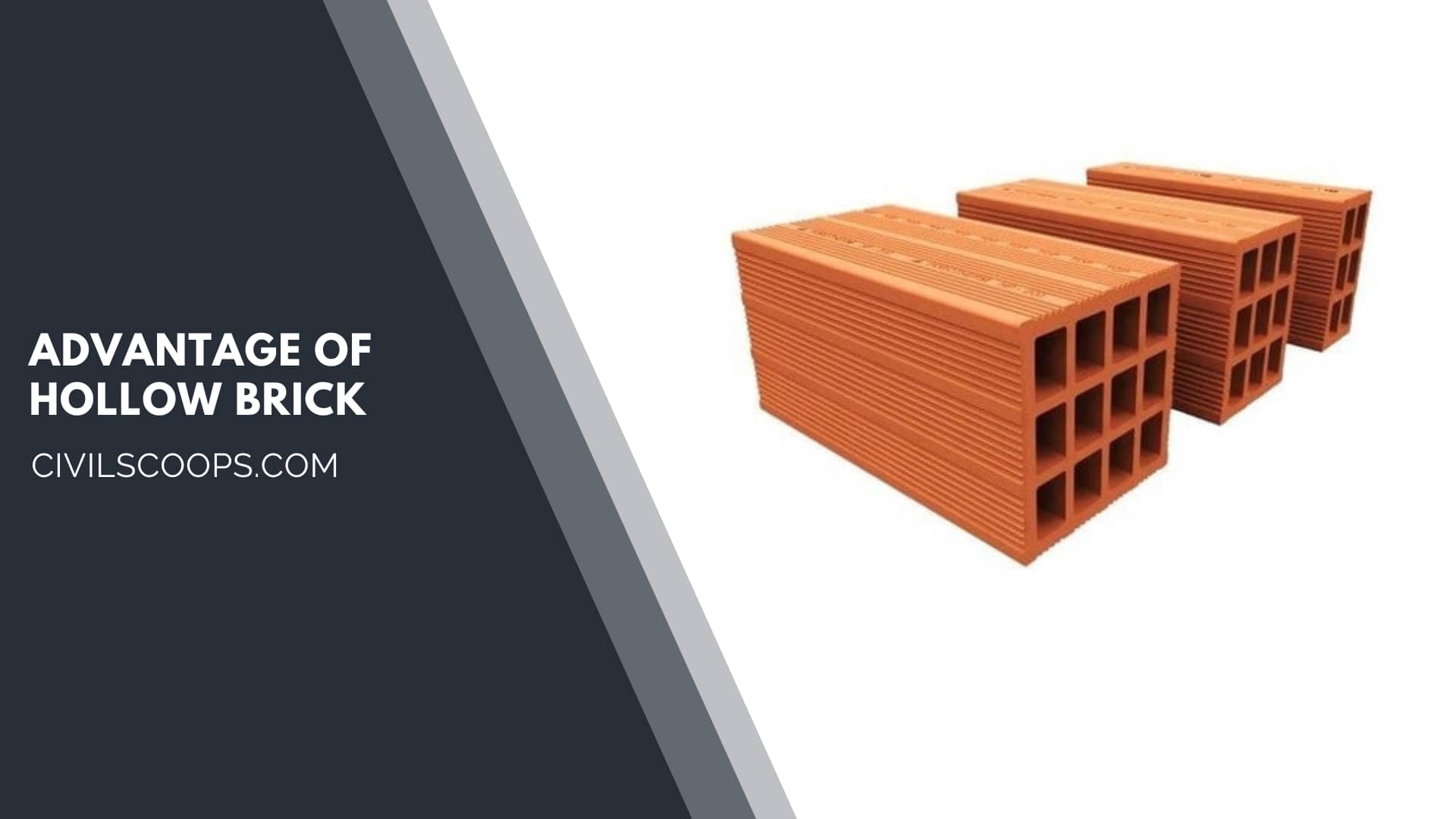
They are various advantages of hollow bricks which are as follows.
- Hollow bricks are an eco-friendly construction material that does not lead to pollution.
- The hollow bricks help to reduce the cooling and heating effect as per the weather requirements due to their thermal insulation property.
- Hollow bricks help to conserve energy and resources.
- The hollow bricks provide good sound insulation properties.
- Hollow bricks have good compressive strength so it is used for the construction of load-bearing walls.
- One of the best advantages of hollow brick construction is that it is also used to pass the electrical as well as plumbing fixtures through its Hollow space.
- Hollow bricks are cost-effective and required very less maintenance.
- Hollow bricks have more fire resistance as compared to solid bricks.
Disadvantage of Hollow Bricks
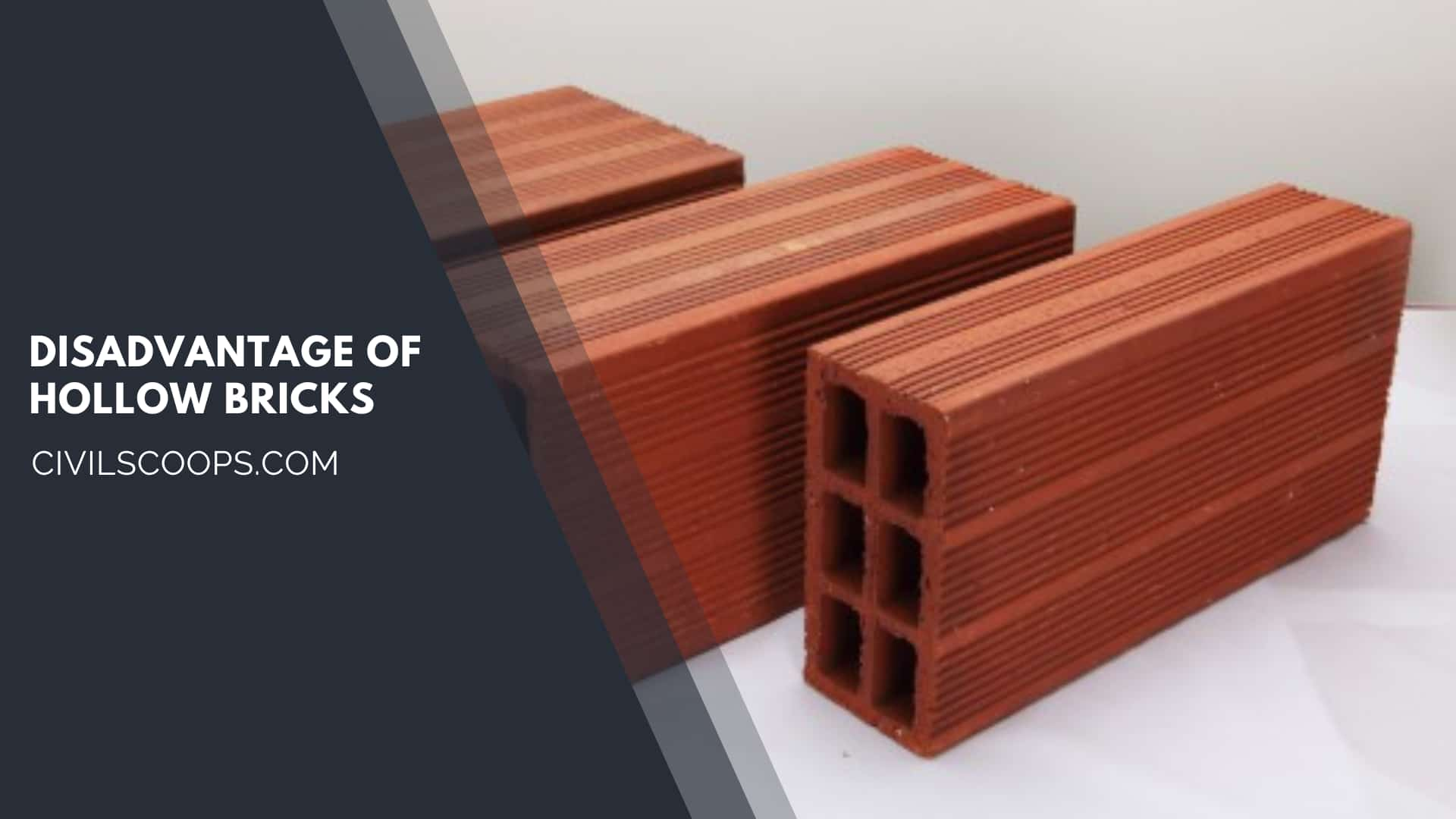
There are also some disadvantages of the hollow bricks which are as follows.
- The load-bearing capacity of hollow bricks is a little low because of the pores as compared to the solid Bricks.
- One of the disadvantages of Hollow bricks is that they cannot be used in the construction of large structures and foundations of buildings.
- The hollow bricks are not suitable in areas where the water table is high because the bricks cannot resist it because of their low density.
Uses of Hollow Bricks

Following are some of different uses of hollow bricks;
- Huge structures demand the building materials have less weight so as to reduce the superimposed load of the structure on soil, hollow brick is a common engineer’s choice in such circumstances.
- Hollow bricks are used to reduce the cost of construction by reducing the amount of mortar used.
- The manufacturing process of hollow brick is environment friendly, hence used in areas prone to pollution.
- Used when steel is to be reinforced within the masonry wall or similarly when electrical wires and plumbing fittings are to be passed through constructed walls.
- The use of hollow brick in boundary fences is cost-efficient.
- Hollow Bricks are used in constructions where the dead load imposed on the foundation is to be reduced.
Sizes of Bricks Blocks
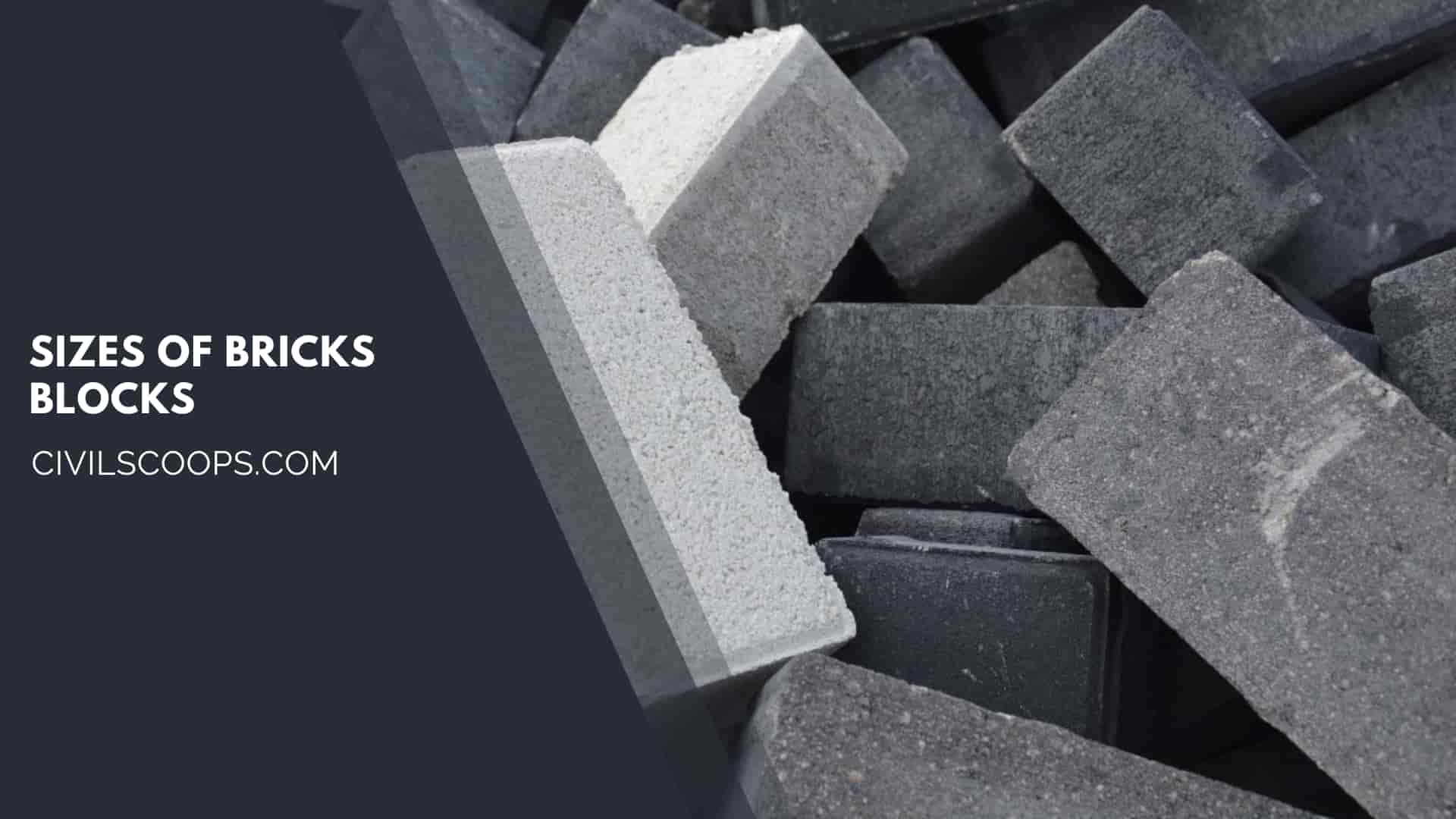
Hollow bricks blocks are available in various sizes in the market but the commonly used sizes of bricks blocks are as follows
- 400 mm x 200 mm x 100 mm
- 400 mm x 200 mm x 150 mm
- 400 mm x 200 mm x 200 mm
- 400 mm x 200 mm x 300 mm
Hollow Brick Price
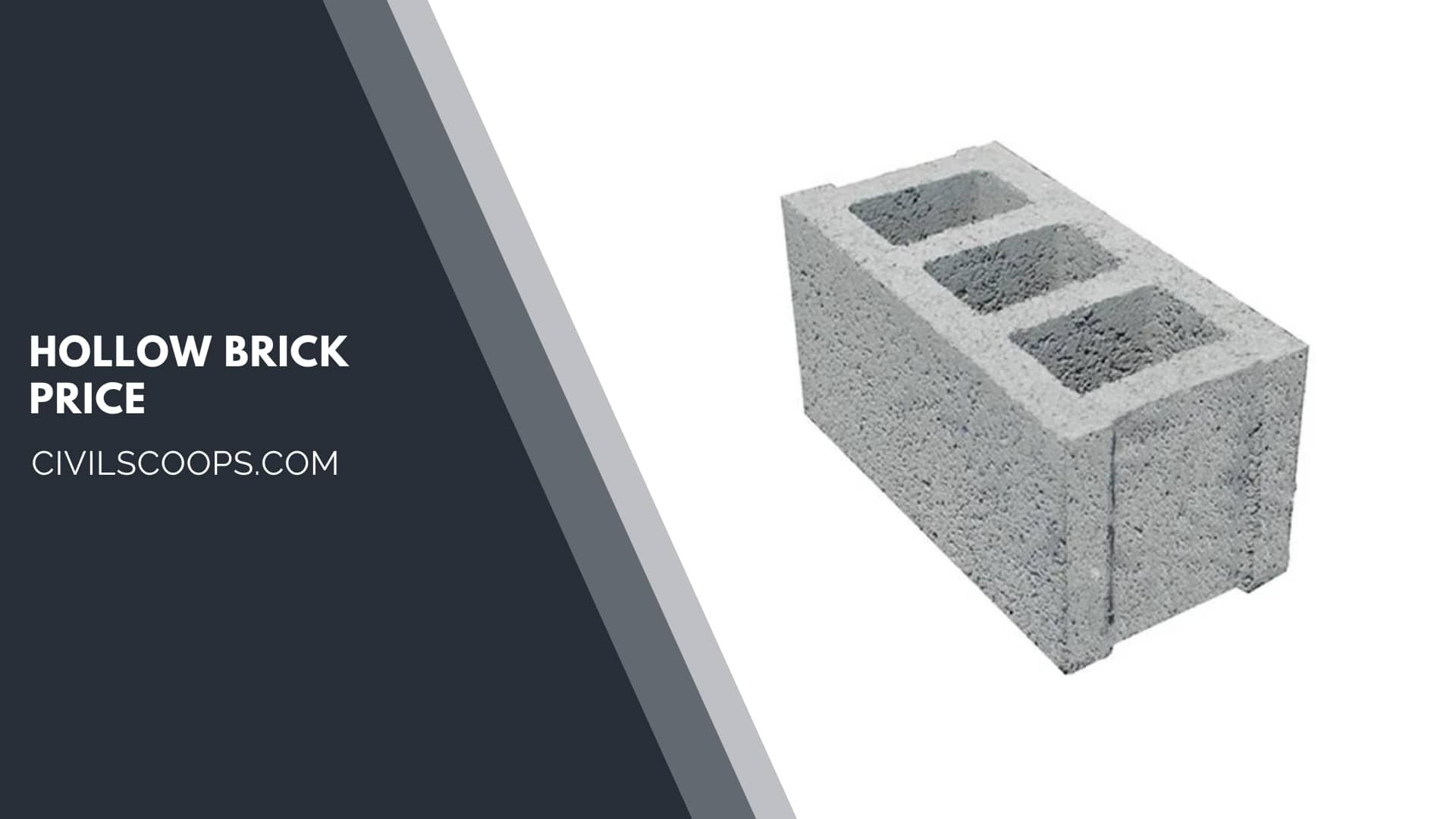
The price of hollow brick varies from place to place and also depends on the quality of the brick i.e. the strength of the brick. Overall, the price could also change depending on the purpose of use.
Bricks used for partition purposes cost less as compared to bricks used for the load-bearing cause. Hence the price of brick varies due to its quality, strength, purpose, and area.
Hollow brick price varies from 0.3$ to 0.8$ or Rs. 25 to Rs. 50 depending on the brick property. But in general, the average cost of a hollow brick is between 0.4 to 0.7$ or Rs.30 to Rs.40 when it comes to cities.
How to Make Hollow Bricks?
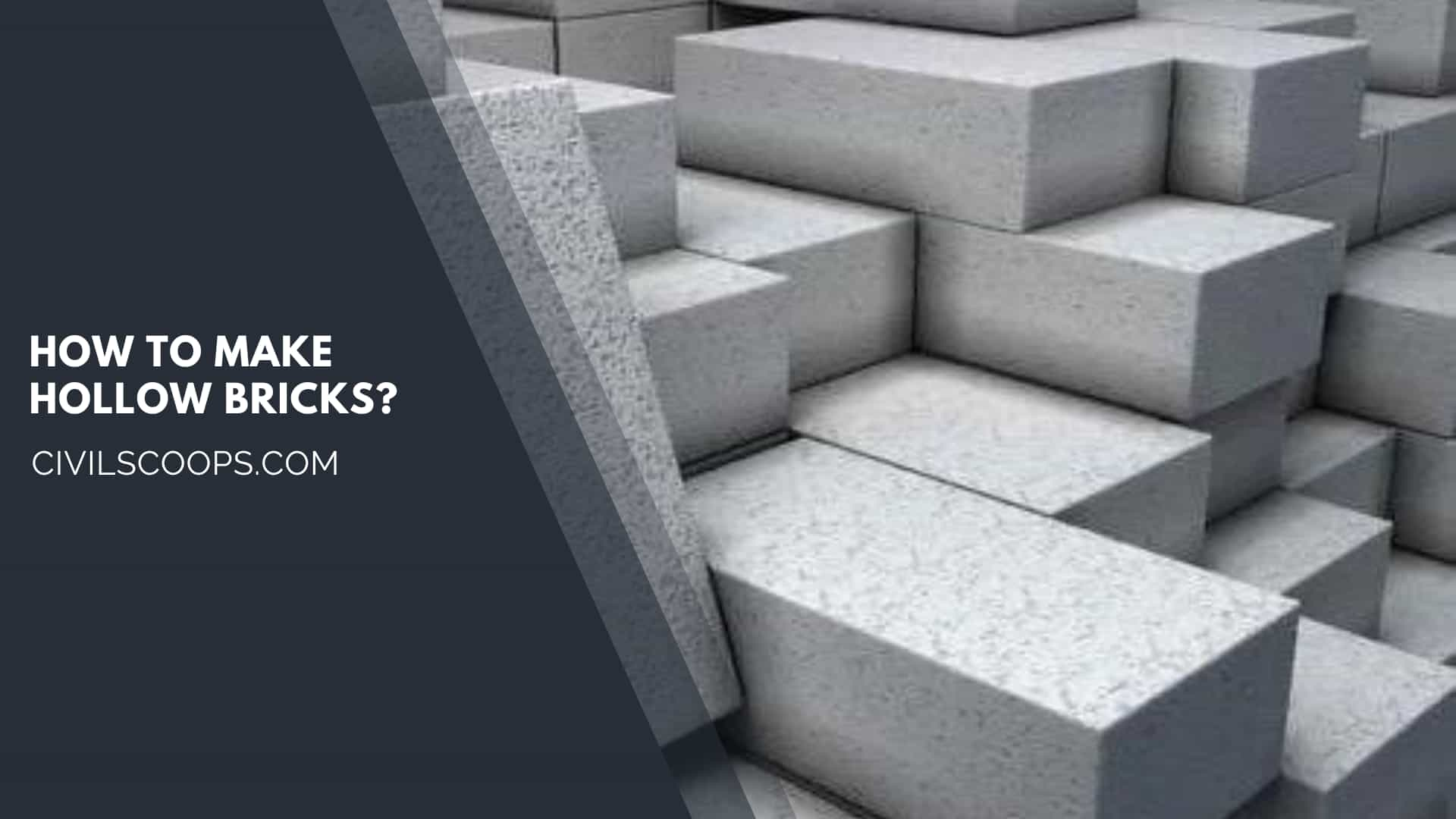
- The hollow bricks are constructed with the help of clay. The hollow bricks have a plane surface such that it requires less amount of material for plastering.
- Hollow bricks have less density as compared to solid bricks because of the presence of holes in them which makes them less dense and lightweight.
- The hollow bricks are manufactured at the site. First of all the raw materials are collected which is required for the manufacturing of the hollow bricks.
- The proportioning of the raw materials is done as per the requirement and it is properly mixed. If the hollow brick is made from cement then the material is mixed in the rotator.
- After proper mixing, the material is filled in the molds of the hollow bricks and compacted properly such that there should not be any voids remaining in it.
- Then the hollow bricks are kept in the water tank for 7 days for the purpose of curing. Now the hollow bricks are ready to use for the construction.
Properties of Hollow Brick

5 Properties of Hollow Bricks are below.
- Compressive Strength of Hollow Brick
- Sound Resistance of Hollow Brick:
- Water Penetration Resistance of Hollow Brick:
- Flexural Strength of Hollow Brick:
- Fire Resistance of Hollow Brick:
1. Compressive Strength of Hollow Brick
The compressive strength of hollow brick can be reported on either a gross or net cross-sectional area basis, depending on how the value is to be used. The gross area compressive strength is used to determine compliance with ASTM C652, Standard Specification for Hollow Brick (Hollow Masonry Units Made From Clay or Shale) for purposes of durability and empirical design requirements.
The net area compressive strength is needed for structural computations in structural applications using rational design of masonry. An internal BIA survey conducted in 1994 showed that the range of compressive strength of 6 to 8 in. (152 to 203 mm) thick hollow brick based on gross cross-sectional area is between 2190 psi (15.1 MPa) and 12,795 psi (88.2 MPa), with an average compressive strength equal to 6740 psi (46.5 MPa).
More recent testing indicates hollow bricks of 3- to 4-in. (76- to 102-mm) nominal thickness have similar compressive strengths as solid units of the same size.
Brick units generally have higher compressive strengths than other load-bearing masonry materials. This makes hollow brick particularly well-suited for reinforced masonry applications where the increased strength of the unit can allow thinner wall sections to handle the same loading.
2. Sound Resistance of Hollow Brick:
Because sound insulation increases with increasing wall weight, brick masonry provides very good sound penetration resistance. The sound transmission class (STC) rating is used to determine the sound insulation of walls.
A hollow brick veneer generally has an STC of approximately 40 to 45, slightly less than the STC of 45 for solid brick veneers of the same thickness.
The STC for through-the-wall brick units is typically calculated as a linear function of weight. A grouted 8-in. (203-mm) brick wall generally has an STC of approximately 50 to 55.
In the absence of test results for a particular wall, calculated values of STC ratings can be determined from the following equation:
STC = 19.6W 0.23 (Imperial) or 913.6W 0.23 (SI)
The STC rating is a function of the weight of the wall, W, expressed in pounds per cubic foot (kg/m3). This equation is a best-fit curve based on the average of historical test data.
3. Water Penetration Resistance of Hollow Brick:
The factors responsible for Water Penetration Resistance for Hollow Bricks are the materials, wall construction, and the workmanship used.
Drainage wall systems prove to be the best water penetration resistance to hollow brick walls. By proper detailing, including clean air spaces, through-wall flashing, and weeps proper water penetration resistance is likely to be excellent.
Hollow Brick delays and reduce dampness in masonry walls proving a good Water Penetration Resistance material providing low water leakage.
Cavity cells in hollow brick delay the appearance of dampness and also reduce the percentage area of dampness as compared to solid bricks of the same size and property.
The same cavity cells are responsible for the less contact area with the mortar, resulting in the well water-resistant scenario. Hollow bricks are used as single–Wythe walls and designed to act as a variation of a barrier wall, depending on the thickness and mass of the materials acting as an obstacle to water penetration.
The single-Wythe wall design is not much good resistant to water penetration as that of drainage wall systems or multi–Wythe barrier wall systems and is not appropriate for some of the exposures.
4. Flexural Strength of Hollow Brick:
The flexural tensile strength of hollow brick masonry is influenced by mortar and unit configurations and the use of reinforcing steel.
Previous research has indicated that face-shell bedded hollow brick masonry exhibits a lower flexural tensile strength than solid brick masonry laid with the same mortar, fully bedded.
This is likely due to the relative thickness of the face-shell bedded mortar joints and the drying of the mortar before the hollow unit is laid (face-shell bedding has more surface area exposed to air relative to its volume than does a full mortar bed).
More recent research has indicated that the percentage of voids, ranging from approximately 22 to 35 percent, in nominal 4-in. (102-mm) brick has no significant effect on the flexural strength of the resulting fully bedded masonry prism.
5. Fire Resistance of Hollow Brick:
The excellent quality of brick as a fire-resistant material is well known. However, very few tests have been carried out on hollow bricks because of the acceptance that bricks are inherently a good fire-resistant material.
Bricks that are made of fired clays are excellent fire-resistant materials. Apart hollow bricks are less fire-resistant when compared to fired clay bricks.
[su_box title=”FAQ” style=”default” box_color=”#333333″ title_color=”#FFFFFF” radius=”3″ class=”” id=””]
What Is Hollow Bricks?
Hollow brick are defined as having greater than 25 percent and at most 60 percent void areas. Hollow brick are further classified into those with a void area not greater than 40 percent and those with greater than 40 percent voids.
Uses of Hollow Bricks
Typical single-wythe applications of hollow brick include commercial, retail and residential buildings; hotels; schools; noise barrier walls; and retaining walls. The second application of hollow brick is as veneer units. These brick are generally 3 to 4 in.
Size of Standard Hollow Blocks
Typically, concrete masonry units have nominal face dimensions of 8 in. (203 mm) by 16 in. (406 mm), available in nominal thicknesses of 4, 6, 8, 10, 12, 14, and 16 in. (102, 152, 203, 254, 305, 356, and 406 mm).
Hollow Brick Vs Solid Brick
Solid brick are defined as having holes (or voids) not greater than 25 percent of the unit’s bed area. Hollow brick are defined as having greater than 25 percent and at most 60 percent void areas.
Hollow Brick Construction
Hollow bricks are an Eco-friendly Construction material that is manufactured by recycled waste and materials like coal ash, rice husk, and fly ash. It is certified by the Green Building Council of India. One of the main functions of hollow bricks is to reduce the dead load of the Structure.
Hollow Block Building Construction
Hollow blocks, which have holes that take up more than one-quarter (and usually more than half) of their cross-sectional area, are used when building boundary fences and other large structures. The holes make them lighter and can be useful when running wiring or piping through them.
What Are Hollow Concrete Blocks Used for?
Hollow blocks are often used to build large structures like boundary fences. The reduced volume of concrete used to make each block adds up to a significant savings in cost for the materials for the whole wall. Their lighter weight also makes them easier to lift.
Why Are Cinder Blocks Hollow?
Concrete blocks may be produced with hollow centers (cores) to reduce weight, improve insulation and provide an interconnected void into which concrete can be poured to solidify the entire wall after it is built.
Why Are Hollow Blocks Hollow?
Hollow blocks, which have holes that take up more than one-quarter (and usually more than half) of their cross-sectional area, are used when building boundary fences and other large structures. The holes make them lighter and can be useful when running wiring or piping through them.
Hollow Blocks Using Waste Materials
A new type of hollow blocks can be fabricated out of wood wastes, agricultural wastes and soil mixed with minimum amount of cement. As far as strength and durability are concerned, results of test showed that this type of blocks is comparable to some of the commercial or traditional concrete hollow blocks.
What Is the Mixture of Hollow Blocks?
Gravel, sand, water, and cement make up hollow blocks. They produce light gray blocks with high compression strength and surface texture. Replacing gravel and sand with slate, shale, and clay makes lightweight hollow blocks.
How Many Hollow Blocks in One Bag of Cement?
1 bag of cement can lay approximately 70 to 80 cement blocks.
How Much Concrete to Fill Hollow Blocks?
The core volume of a standard size 6-inch concrete block is approximately 392 in³ or 0.006424 m³. From our calculations above, we can now say that we need around 0.5782 m³ of concrete or mortar to fill the concrete blocks that we will use to construct our wall.
Mixture of Sand and Cement for Hollow Blocks
The mixing ratio is 1 part cement and 5 parts sand, and if the plaster is too harsh, 0.5 to 1 part of lime can be added.
How to Make Hollow Blocks from Plastic?
The plastic waste are first pulverized. Then two sacks of the pulverized plastic are mixed with a bag of cement and 15 pails of sand. The mixture is then poured into a molder. This produces about 140 to 150 hollow blocks.
Hollow Block Mixing Ratio
As per Indian Standard specifications, the combined aggregate content in the concrete mix used for making hollow blocks should not be more than 6 parts to 1 part by volume of Portland cement. If this ratio is taken in terms of weight basis this may average approximately at 1:7 (cement : aggregate).
Hollow Block Manufacturing Process
There are four fundamental processes in creating hollow blocks: mixing, molding, curing, and cubing. Some plants are capable of making more than 2,000 blocks per hour. Other manufacturing plants also precast concrete blocks products like flat paver stones and decorative pieces of landscaping like lawn endings.
How to Estimate Hollow Blocks?
Calculate the area of a block by multiplying its height and width. Divide your wall area by the block area. The result is the total amount of blocks you need.
Hollow Blocks Ingredients
Gravel, sand, water, and cement make up hollow blocks. They produce light gray blocks with high compression strength and surface texture. Replacing gravel and sand with slate, shale, and clay makes lightweight hollow blocks.
[/su_box]
[su_note note_color=”#F2F2F2 ” text_color=”#333333″ radius=”3″ class=”” id=””]
Like this post? Share it with your friends!
Suggested Read –
- What Is Building | Types of Building
- Types of Coffered Ceiling | What Is Coffered Ceiling | Coffered Ceiling Cost
- Top-Down Construction | What Is a Top-Down Construction | Advantages & Disadvantages of Top-Down Construction
- All About Retrofitting | What Is Retrofitting | Why Need Retrofitting | Advantages And Disadvantages of Retrofitting of Building
- Automation in Construction | Advantages of Automation | Applications of Automation | Where Are Use Automation in Construction Sector
[/su_note]
Originally posted 2023-03-10 10:42:35.
